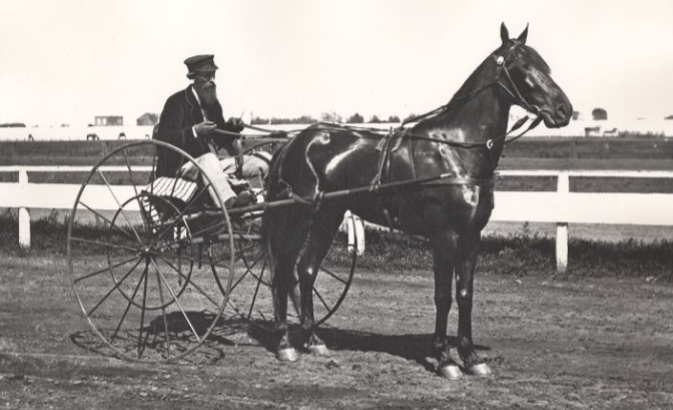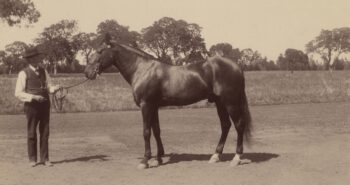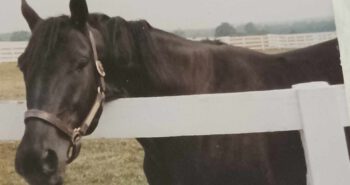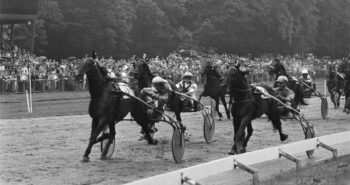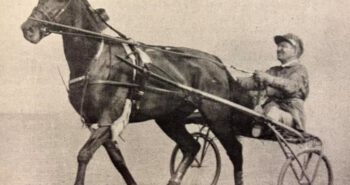The first world champion bred in California, Occident came out nowhere in the early 1870s and tied Goldsmith Maid’s absolute world record in 1873. It was very different to a few years earlier when he was living a life of abuse and ill-treatment. Later he would play a key role in the development of both picture technology but also our understanding of horse gaits.
In 1878, after being commissioned by the wealthy Leland Stanford, Eadweard Muybridge created The Horse in Motion, the first example of chronophotography, the precursor of today’s motion pictures. The Horse In Motion consisted of sets of pictures showing four different horses; Occident and Abe Eddington trotting, and Mahomet and Sallie Gardner running. The very first recorded picture of a horse in motion had been taken five year earlier. Leland Stanford had commissioned Muybridge to somehow record or photograph Occident in action. Muybridge didn’t really think it could be done, but agreed to give it a go anyway.
According to an article in the Daily Alta California on Apr 7, 1873, “All the sheets in the neighborhood of the stable were produced to make a white ground to reflect the object, and Occident was after a while trained to go over the white cloth without flinching; then came the question how could an impression be transfixed of body moving at the rate of thirty-eight feet to the second. The first experiment of opening and closing the camera on the first day left no result; the second day, with increased velocity in opening and closing, a shadow was caught. On the third day, Mr Muybridge, having studied the matter thoroughly, contrived to have two boards slip past each other by touching a spring, and in so doing to leave an eighth of an inch opening for the five-hundredth part of a second, as the horse passed, and by an arrangement of double lenses, crossed secured a negative that shows Occident in full motion – a perfect likeness of the celebrated horse. The space of time was so small that the spokes of the wheels of the sulky were caught as if they were not in motion.” Despite the positive description, the best pictures were blurry and shadowy. Moreover, they were not published and the negatives were lost.
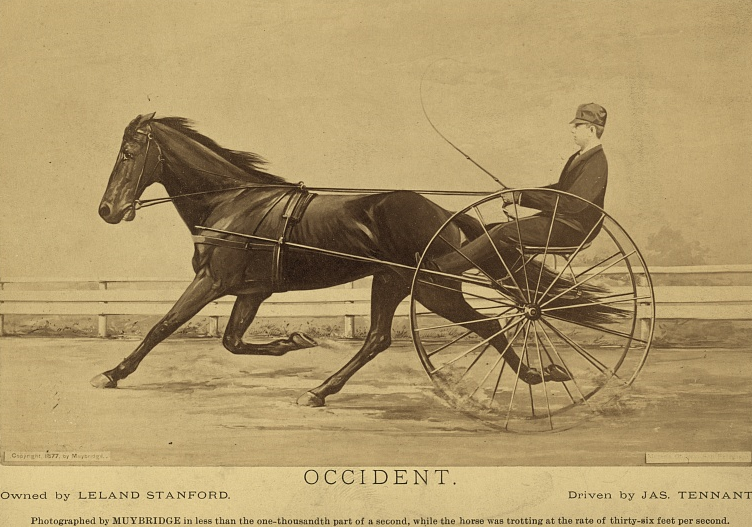
Four years later Muybridge was back at Palo Alto for new attempts at capturing Occident on camera at full speed. Over several days in July 1877, working at Union Park Racetrack in Sacramento, Muybridge was successful at improving the quality noticeably. The published picture, though, was in reality a photo of a painting that artist John Koch had retouched. Leland was very satisfied with the final result and the duo moved on to their next project the following summer. Then Muybridge moved from a single pictures to series depicting the complete stride of the four aforementioned horses, which would also settle the dispute of whether horses had all four feet off the ground (and at what point) when running or trotting. The photographic series garnered worldwide acclaim when they were published on June 15, 1878, and the series depicting Sallie Gardner is often referred to as the world’s first motion picture.
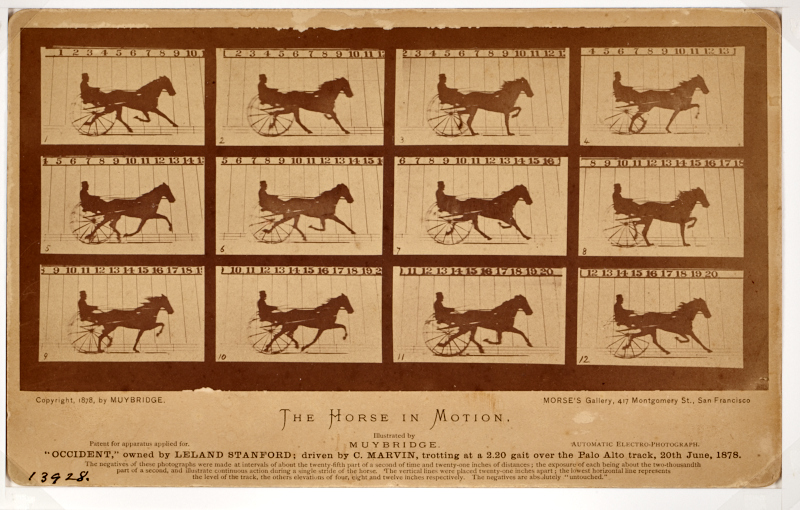
Amassing a huge fortune
But who was Occident, the trotter at the center of this story from the very beginning? He was Leland Stanford’s favorite horse but only became a well-known trotter by happenstance and came into Stanford’s life as a result of a a doctor’s visit. To put it into the biggest picture, let us start with a very brief overview of Stanford’s life. He was born in Watervliet (now Colonie), New York in 1824. According to Roland de Wolk’s article on Stanford posted on whatitmeanstobeamerican.org, “he was a repeated dropout who never graduated from what today would be high school. He claimed to have passed the New York State bar, but the record indicates he did not. He was, not surprisingly, a classic American anti-intellectual, who disparaged people with better educations (…) By the time he was 28, Stanford was dead broke. Letters, manuscripts, and other documents reveal he fled in 1852 to California, where his brothers had already established a successful retail business. With understandable scepticism, the brothers sent Stanford up to the mountainous Gold Country to open a branch store, to see how he would do – and for the first time ever, he did fine (…) When the brothers moved out of their Sacramento headquarters and on to other enterprises, Stanford came back down the hill to take over – and met the partners who would help him accrue his vast wealth.”
Stanford and three other businessmen in Sacramento, Collis Huntington, Mark Hopkins and Charles Crocker founded the Central Pacific Railroad and became known as “the Big Four.” Securing contracts with the government to build the western end of the railroad connecting the East and West coasts, “Stanford and his partners began a ceaseless – and successful – campaign to get still more money out of American taxpayers. They set up dummy companies to launder the proceeds into their own accounts, effectively hiding their true expenses and profits.” Stanford was also voted Governor of California in 1861, and used the office extensively for his personal gain. The railroad construction was to a large extent based on exploitation of severely underpaid Chinese immigrants. When it was completed, the railroad used their monopoly to exploit customers by charging outrageous prices while laundering money through various corporations to avoid paying taxes. Says de Wolk, “A series of subsequent state attempts to investigate the railroad, which would soon change its name to the Southern Pacific, failed in large measure because Stanford bought off the so-called investigators.” Later a commission was set up the by the government to investigate all railroads. They started with Stanford’s company and found it had lied to and defrauded the American people. In 1887 the commission took him to court, but as two of the three judges were personal friends who Stanford had himself appointed to the bench he won the case, despite the mountain of evidence against him.
The transcontinental railroad was completed on May 10, 1869 and Stanford was given the honor of driving the final spike in a ceremony in Promontory, Utah. The intensely hard work of securing funding, building and running the railroad took its tool on Stanford who broke down physically. His doctor advised him to let up and take up driving horses for relaxation. Shortly after that, in 1870 Stanford bought his first fast horse to drive, Occident.
An abused horse
Occident’s path to being a recognized fast trotter is quite unbelievable. Because of his very humble beginnings, the details of is early life is relatively sketchy. He was bred by Mathew Shaw of Sacramento Country and was a son of Doc, today referred to as Medoc, while his dam, Mater Occidentis, was “a good mare of unknown pedigree.” Medoc, to use the name common today, was a son of the famous St Clair, a Morgan horse whose sireline goes straight back to Justin Morgan. Occident is thus himself a Morgan horse. Known as Charley early in life, Occident was sold for a nominal price before he was broken, and at six years of age he was one of a team that hauled sand on the streets of Sacramento. According to the story widely reported when he passed away, Occident was first bought by a Sacramento butcher who treated him with cruelty, which in turn made him vicious. Sold to a duck hunter who then had him hauling a sand wagon, the treatment continued in the hands of his new owner. Tired of his mean and difficult horse, in the early summer of 1869, “he was sold to a German grocer, with all his bad habits of kicking, biting, pulling at the halter, and running away, for which he had received many a lash and naught but the harshest treatment. But the German commenced to pat and pet and feed his new horse plenty, and in two months the horse became fat, sleek and gentle, docile as a lamb. From this time out he has ever been trusty.”
Pulling the grocer’s wagon, Occident showed a pure and fast trotting gait which enticed Sydney Eldred to buy him for $300 two or three months after he had been bought by the unnamed grocer. Says an article in the Breeder and Sportsman, “before purchasing, Mr Eldred was convinced there was something in him, and to prove his judgement correct, when put in training he acquired the fast trotting action very rapidly. He showed 3:20 (2.04,3) to a buggy the day of purchase, and in about three months’ time he could trot in 2:40 (1.39,4). Satisfied with this, his owner turned him out for the winter, placed him in training again in the spring of 1870 and on the first of July he trotted a half-mile in 1:12 1/2 (1.30,1).” On Jul 3, 1870, Leland Stanford bought the fast Morgan trotter for $4,000 in gold coin and another horse valued at $500.
A remarkable rise
Stanford put Occident in the hands of trainer AF Smith. The seven-year-old rapidly improved an on Oct 7, 1870, Stanford drove Occident to a road wagon in 2:30 (1.33,2). On May 19, 1871, Occident was exercised in front of several members of the famous Americus Club of New York visiting Califonia. He then trotted a half in 1:07 1/2 and a mile in 2:22 3/4 (1.28,7). Occident thus quickly gained a reputation as “the California wonder” even though he hadn’t started in a single race. Without any races available, Smith kept training Occident at the Union Park Course in Sacramento. On Nov 23, 1871 he was given his first regular trial of three heats, which he did in the world record 2:18 1/2, and 2:19 and 2:19 1/4 (1.26,0, 1.26,4 and 2.26,5).
In the fall of 1872, the star mares Goldsmith Maid and Lucy made their way to California from the West Coast. A few months prior Occident had been moved from Smith to to James Eoff because of his former trainers declining health. In mid-September 1872, the San Francisco Chronicle told he story of the first time Budd Doble, trainer of Goldsmith Maid, and Orrin Hickok, trainer of St Julien and others, laid their eyes on Occident; “to a disinterested observer, it was a curious sight to watch the expressions of Doble and Hickok’s faces as the door of Occident’s box swung open and their eyes fell for the first time upon the trotting wonder of California, whose name and fame have gone out through all the horse-loving world. Occident gave his distinguished visitors a curious look, and seemed a little astonished at their good clothes and general nobby appearance. Budd looked him all over with the eye of a critic. He examined his feet and legs, passed his hand over his sides and down his rump and thighs, looked into his eyes and mouth, and then stood off ten feet and again took him in.
Then he turned to Hickok and said, ‘I never saw but one horse built exactly like him, and I know he could trot like a streak of lightning! That’s Erastus Corning’s George Palmer. He’s just another such a horse as this. I’ll be this fellow can trot. Look at those legs! Look at his general putup – that short joint between the hock and fetlock, and the whole shape of the hind leg. It’s made like the crank of a locomotive.’
They stood and looked at the horse several minutes longer. Neither spoke again about him though the eye of every one in the party was on Budd. It was evident to all that both he and Hickok thought well of the horse, and will expect great things of him.”
A world record
In a match race between Goldsmith Maid and Occident in Sacramento on Oct 16, 1872, the mare won easily in front of a disappointed home crowd as Occident was clearly second beat in all three heats and two weeks later he lost to Lucy. Separately, when Goldsmith Maid and Lucy had a match race, in between their heats Occident trotted two heats to sulky in 2:21 1/2 (1.27,9) and one heat to wagon in 2:23 1/2 (1.29,2), the latter being half a second faster than the existing wagon world record. At the end of the year, Orrin Hickok offered $10,000 to lease Occident for one year, but Stanford turned him down.
In 1873, the California State Agricultural Society put up a $2,000 gold plate to any horse that would beat the best time made in California. On Sep 17, 1873, Occident had a go at the record, a which was 2:17 1/4 (1.25,3) set by Goldsmith Maid the year prior. According to the Sacramento Bee, “so impossible did it seem for the horse to win the plate that few could be found to bet that he would do it, but there were many who did bet that he would not make 17 1/2, 18 and some even bet against 18 3/4. Occident, however, was equal to the occasion, and surprised and delighted all by winning the plate, making the unprecedented California time of 2:16 3/4 (1.25,0). In fact this time has never before been equalled but once, and that was by Goldsmith Maid, who did the mile at Boston in 2:16 3/4. (…) George Tennent, the driver in yesterday’s race is, comparatively, a green hand at the business, but he has now made a reputation for himself which is worth something in his line. The result of this race has set many to expressing opinions that had Occident been properly handled in his races with Lucy and Goldsmith Maid, he would have won one of them, at least. At all events, it puts to rest the sneering insinuations of cavillers that the reports published of Occident’s private time performances were bogus.” The time was also a world record for geldings.
A botched operation
On Oct 31, 1874, Occident defeated Judge Fullerton at San Francisco. The former took the first heat in 2:19 (1.26,4), but Occident came back and won, driven by Budd Doble, in 2:18 and 2:22 3/4 (1.25,8 and 1.28,7). Then, in April 1875, Occident was put in the charge of Budd Doble and sent to the east coast. While there were high hopes ahead of the voyage that the little trotter, Occident was only 15,1 hands (155 cms) tall, would continue his winning ways, it was generally a disappointing journey as the horse was not sound. The San Francisco Examiner explained that “the cause of this disappointment is said to be the result of an operation performed on Occident’s feet a short time prior to his departure from this coast. It was believed by a number of prominent turfmen that Occident could eastly beat his best record if his hoofs were broadened. Accordingly, his hoofs were cut down considerably, and by means of screws placed in the frog it was expected to accomplish the desired object. The operation was supposed to have been successful until the animal was placed in training on a Philadelphia track. He he exhibited the unmistakeable signs of lameness, and was thus prevented from taking part in any of the races. The lameness still manifests itself (four months later, editorial note) but experts say it will soon disappear and leave the horse in as good, if not better condition than ever before. Since Occident has been east, he has been exhibited at Mystic Park, Boston and the race courses at Buffalo, Utica and other prominent cities.”
After returning to California, Occident starting a few more races the next couple of years until September 1878. He was then retired and lived out his life in comfort at Stanford’s Palo Alto Stock Farm, being treated as an absolute king. He died of colic after two hours’ illness at Nov 13, 1885 at Palo Alto Stock Farm, 22 years old. As a final good-bye, The Breeder and Sportsman wrote “in the cosey straw-littered paddock, in all of the enjoyment of one of the glorious California November afternoons, when the sunshine was warm, the air still, and there was the music of birds, respose and contentment on every hand was the last time we saw him. He came up cheerfully, affectionately laid his head on our shoulder, as much as to say ‘Is not this a grand change from the day when you pictured me hauling the heavy load under abuse and all manner of ill-treatment?’ Good bye Occident! After life’s fitful fever you will sleep well under the oaks which guard the banks of the San Francisquita.”
It is unclear if Occident, or his hooves and heart, as was occasionally practice in the past, was ever buried under the oaks on the banks of the San Francisquita (on present-day Stanford University campus). His skeleton was, though – together with those of Electioneer and Palo Alto – was on display in the Leland Stanford Junior Museum until the 1906 San Francisco earthquake on Apr 18, 1906. Although plans were made to reassemble them, they were eventually pitched. This has probably contributed to Occident today being completely forgotten. It’s a shame, because the trotter played an remarkable part in both the history of trotting and photography and deserves to be remembered.
occident
(ex: Charley)
Bay gelding born in Sacramento, CA in 1863. Died at Palo Alto, CA on Nov 13, 1885.
Medoc – Mater Occidentis (unknown sire)
2:16 3/4 (1.25,0)
Breeder: Mathew Shaw
Owners: Mathew Shaw – unknown owners – Sydney Eldred – Leland Stanford
Trainers: AF Smith, Jim Eoff, Jimmy Tennant and Budd Doble
Drivers: Jim Eoff, Jimmy Tennant, Budd Doble and George Tennant
Grooms: George Tennant

